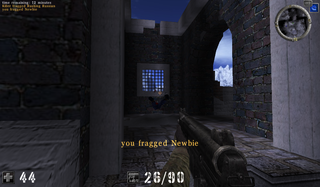
Deathmatch, also known as free-for-all, is a gameplay mode integrated into many shooter games, including first-person shooter (FPS), and real-time strategy (RTS) video games, where the goal is to kill the other players' characters as many times as possible. The deathmatch may end on a frag limit or a time limit, and the winner is the player that accumulated the greatest number of frags.

Netrek is an Internet game for up to 16 players, written almost entirely in cross-platform open-source code. It combines features of multi-directional shooters and team-based real-time strategy games. Players attempt to disable or destroy their opponents' ships in real-time combat, while taking over enemy planets by bombing them and dropping off armies they pick up on friendly planets. The goal of the game is to capture all the opposing team's planets.
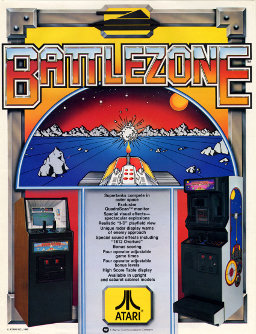
Battlezone is a first-person shooter tank combat game released for arcades in November 1980 by Atari, Inc. The player controls a tank which is attacked by other tanks and missiles. Using a small radar scanner along with the terrain window, the player can locate enemies and obstacles around them in the barren landscape. Its innovative use of 3D graphics made it a huge hit, with approximately 15,000 cabinets sold.
Spasim is a 32-player 3D networked space flight simulation game and first-person space shooter developed by Jim Bowery for the PLATO computer network and released in March 1974. The game features four teams of eight players, each controlling a planetary system, where each player controls a spaceship in 3D space in first-person view. Two versions of the game were released: in the first, gameplay is limited to flight and space combat, and in the second systems of resource management and strategy were added as players cooperate or compete to reach a distant planet with extensive resources while managing their own systems to prevent destructive revolts. Although Maze is believed to be the earliest 3D game and first-person shooter as it had shooting and multiplayer by fall 1973, Spasim has previously been considered along with it to be one of the "joint ancestors" of the first-person shooter genre, due to earlier uncertainty over Maze's development timeline.
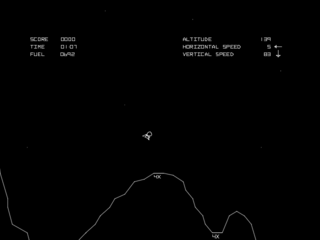
Lunar Lander is a genre of video games loosely based on the 1969 landing of the Apollo Lunar Module on the Moon. In Lunar Lander games, players control a spacecraft as it falls toward the surface of the Moon or other astronomical body, using thrusters to slow the ship's descent and control its horizontal motion to reach a safe landing area. Crashing into obstacles, hitting the surface at too high a velocity, or running out of fuel all result in failure. In some games in the genre, the ship's orientation must be adjusted as well as its horizontal and vertical velocities.

M1 Tank Platoon is a tactical simulator of tank warfare developed and published by MicroProse for the Amiga, Atari ST and MS-DOS in 1989. The game features a mixture of first-person, third-person tank warfare, and tactical simulation gameplay. It was followed by a sequel, M1 Tank Platoon II, released by MicroProse in 1998 for Windows. M1 Tank Platoon was sold to Interplay Entertainment in 2009. M1 Tank Platoon is available on Steam and Epic Games services.
2.5D perspective refers to gameplay or movement in a video game or virtual reality environment that is restricted to a two-dimensional (2D) plane with little to no access to a third dimension in a space that otherwise appears to be three-dimensional and is often simulated and rendered in a 3D digital environment.

Shooter video games or shooters are a subgenre of action video games where the focus is on the defeat of the character's enemies using ranged weapons given to the player. Usually these weapons are firearms or some other long-range weapons, and can be used in combination with other tools such as grenades for indirect offense, armor for additional defense, or accessories such as telescopic sights to modify the behavior of the weapons. A common resource found in many shooter games is ammunition, armor or health, or upgrades which augment the player character's weapons.
Close Combat is the name of a series of real-time computer wargames by Atomic Games. In the Close Combat series, the player takes control of a small unit of troops and leads them in battles of World War II from a top down 2D perspective.

Tron is a coin-operated arcade video game manufactured and distributed by Bally Midway in 1982. The game consists of four subgames inspired by the events of the Walt Disney Productions motion picture Tron released earlier in the summer. The lead programmer was Bill Adams. The music programmer was Earl Vickers.

PLATO, also known as Project Plato and Project PLATO, was the first generalized computer-assisted instruction system. Starting in 1960, it ran on the University of Illinois's ILLIAC I computer. By the late 1970s, it supported several thousand graphics terminals distributed worldwide, running on nearly a dozen different networked mainframe computers. Many modern concepts in multi-user computing were first developed on PLATO, including forums, message boards, online testing, email, chat rooms, picture languages, instant messaging, remote screen sharing, and multiplayer video games.
Turn-based tactics (TBT) is a sub-genre of strategy video games. They are turn-based simulations of operational warfare and military tactics in generally small-scale confrontations as opposed to more strategic considerations of turn-based strategy (TBS) games. Turn-based tactical gameplay is characterized by the expectation of players to complete their tasks using only the combat forces provided to them in a generally realistic manner.
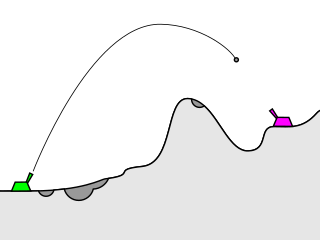
Artillery games are two or three-player video games involving tanks trying to destroy each other. The core mechanics of the gameplay is almost always to aim at the opponent(s) following a ballistic trajectory. Artillery games are among the earliest computer games developed; the theme of such games is an extension of the original uses of computer themselves, which were once used to calculate the trajectories of rockets and other related military-based calculations. Artillery games have been described as a type of "shooting game", though they are more often classified as a type of strategy video game.
Empire is the name of a computer game written for the PLATO system in 1973. It is significant for being quite probably the first networked multiplayer arena shooter-style game. It may also be the first networked multiplayer action game.
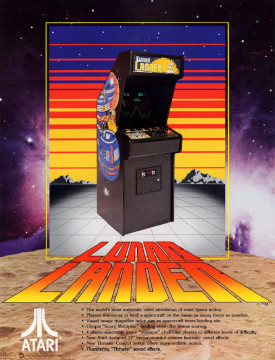
Lunar Lander is a single-player arcade game in the Lunar Lander subgenre. It was developed by Atari, Inc. and released in August 1979. It was the most popular version to date of the "Lunar Lander" concept, surpassing the prior Moonlander (1973) and numerous text-based games, and most later iterations of the concept are based on this Atari version.

In video games, first-person is any graphical perspective rendered from the viewpoint of the player character, or from the inside of a device or vehicle controlled by the player character. It is one of two perspectives used in the vast majority of video games, with the other being third-person, the graphical perspective from outside of any character ; some games such as interactive fiction do not belong to either format.
A variety of computer graphic techniques have been used to display video game content throughout the history of video games. The predominance of individual techniques have evolved over time, primarily due to hardware advances and restrictions such as the processing power of central or graphics processing units.

A first-person shooter (FPS) is a video game centered on gun fighting and other weapon-based combat seen from a first-person perspective, with the player experiencing the action directly through the eyes of the main character. This genre shares multiple common traits with other shooter games, and in turn falls under the action games category. Since the genre's inception, advanced 3D and pseudo-3D graphics have proven fundamental to allow a reasonable level of immersion in the game world, and this type of game helped pushing technology progressively further, challenging hardware developers worldwide to introduce numerous innovations in the field of graphics processing units. Multiplayer gaming has been an integral part of the experience, and became even more prominent with the diffusion of internet connectivity in recent years.

Bolo is a video game written by Jim Lane for the Apple II and published by Synergistic Software in 1982. It was inspired by Keith Laumer's 1976 science fiction novel Bolo: Annals of the Dinochrome Brigade, which featured self-aware tanks.

Soviet Strike is a helicopter-based shooter game developed and published by Electronic Arts for the PlayStation in 1996 and the Sega Saturn in 1997. The game is a sequel to the Strike games which began on the Sega Genesis with Desert Strike: Return to the Gulf. Soviet Strike is the series' first installment for a 32-bit console and was first conceived as 32-bit Strike. Early on, it was intended for the 3DO platform, before development changed to the PlayStation.













